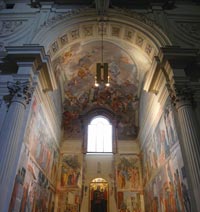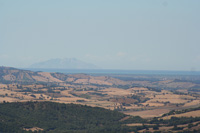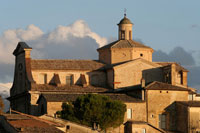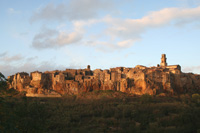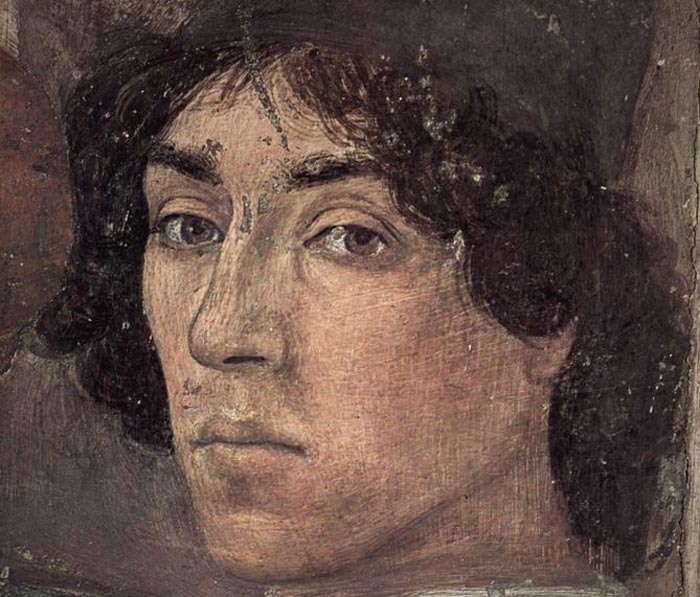 |
|
Filippino Lippi (1457-1504) |
|
Filippino Lippi (1457-1504) |
He was a painter of altarpieces, cassone panels and frescoes and also an exceptional draughtsman. His success lay in his ability to absorb, without slavishly following, the most popular trends in contemporary painting. He worked in Florence and Rome at a time when patrons were beginning to intermingle personal, religious, social and political ideals in their ambitions for palaces and chapels: with the support of wealthy and erudite patrons, such as Lorenzo de’ Medici (‘il Magnifico’) and Filippo Strozzi, he won important civic and private commissions. |
| Born Filippo Lippi in Prato (Tuscany), the illegitimate son of the painter Fra Filippo Lippi and Lucrezia Buti, Filippino first trained under his father. They moved to Spoleto, where Filippino served as shop adjuvant in the construction of the Cathedral there. When his father died in 1469, he completed the frescos with Storie della Vergine (Histories of the Virgin) in the cathedral. Filippino Lippi completed his apprenticeship in the workshop of Botticelli, who had been a pupil of Filippino's father. In 1472, Botticelli also took him as his companion in the Compagnia di San Luca. His first works greatly resemble those of Botticelli's, but with less sensitivity and subtlety. The very first ones (dating from 1475 onwards) were initially attributed to an anonymous "Amico di Sandro" ("Friend of Botticelli"). Eventually Lippi's style evolved into a more personal and effective one in the years 1480-1485. Works of the early period include: the Madonnas of Berlin, London and Washington, the Journeys of Tobia of the Galleria Sabauda in Turin, Italy, the Madonna of the Sea of Galleria dell'Accademia and the Histories of Ester. Together with Perugino, Ghirlandaio and Botticelli, Lippi worked on the frescoed decoration of Lorenzo de Medici's villa at Spedaletto. On December 31, 1482 he was commissioned to work on a wall of Sala dell'Udienza of Palazzo Vecchio in Florence (a work never begun). Soon after (probably in 1483-1484) he was called to complete Masaccio's decoration of Brancacci Chapel in the church of the Carmine, left unfinished by the artist's death in 1428 . Here he realized the Stories of Saint Peter on the following frescoes: Quarrel with Simon Magus in face of Nero, Resurrection of Teophilus' Son, Saint Peter Jailed, Liberation and Saint Peter's Crucifixion. The work on the Sala degli Otto di Pratica, in the Palazzo Vecchio, started on February 20, 1486. It is now in the Uffizi Gallery. In the same years Piero di Francesco del Pugliese asked him to paint the altarpiece with Apparition of the Virgin to St. Bernard, now in the Badia Fiorentina, Florence. This is Lippi's most popular picture: a composition of unreal items, with its very particular elongated figures, backed by a phantasmagorical scenario of rocks and almost anthropomorphic trunks. The work can be dated to the 1480–1486 years. Eventually he worked for Tanai de' Nerli in the Saint Spirit's Church. On April 21, 1487, Filippo Strozzi asked him to decorate the family chapel in Santa Maria Novella with the Stories of St. John Evangelist and St. Philip. He worked on this piece intermittently, only completing it in 1503, after the customer's death. The windows with musical themes, also designed by Filippino, were completed between June and July 1503. These paintings can be seen as a mirror of the political and religious crisis in Florence at the time: the theme of the fresco, the clash between Christianity and Paganism, was hotly debated in the Florence of Girolamo Savonarola. Filippino showed his characters in a landscape which recreated the ancient world in its finest details, showing the influence of the Grottesco style he had seen in his journey to Rome. He created in this way an "animated", mysterious, fantastic but also disquieting style, showing the unreality of something as a nightmare. In this way, Filippino portrayed ruthless executioners deformed by grim faces, who raged against the Saints. In the scene with St. Philip expelling a monster from the temple, the statue of the pagan god is a living figure which seems to dare the Christian saint. In 1488, Lippi moved to Rome, where Lorenzo de' Medici had advised Cardinal Oliviero Carafa to entrust him the decoration of the family chapel in Santa Maria sopra Minerva. These frescoes show a new kind of inspiration, quite different from the earlier works, but confirm his continued research on the themes of the Ancient era. Lippi finished the cycle by 1493. Lippi's return to Florence is variously assigned to the years going from 1491 to 1494 . Works of this period include: Apparition of Christ to Madonna (1493, now in Munich), Adoration of the Magi (1496, for the church of San Donato in Scopeto, now in the Uffizi), Sacrifice of Lacoön (end of the century, for the villa of Lorenzo de' Medici at Poggio a Caiano), St. John Baptist and Maddalena (Valori Chapel in San Procolo, Florence, inspired in some way to Luca Signorelli's art). He also worked outside of his mother-country, namely on the Certosa of Pavia and in Prato, where in 1503 he completed the Tabernacle of the Christmas Song, now in the City Museum; in 1501 Lippi realized the Mystic Wedding of St. Catherine for the Basilica of San Domenico in Bologna. Lippi's last work is the Deposition for the Santissima Annunziata church in Florence, which at his death in April 1504 was unfinished. He was so renowned that all the workshops of the city closed on the day of his burial. |
Filippo (Filippino) Lippi | Brancacci Chapel in Santa Maria del Carmine, Florence |
||
Filippino Lippi's first major work was to complete in 1484-85 the fresco cycle in the Cappella Brancacci of Santa Maria della Carmine in Florence, started by Masaccio and Masolino several decades before. |
||
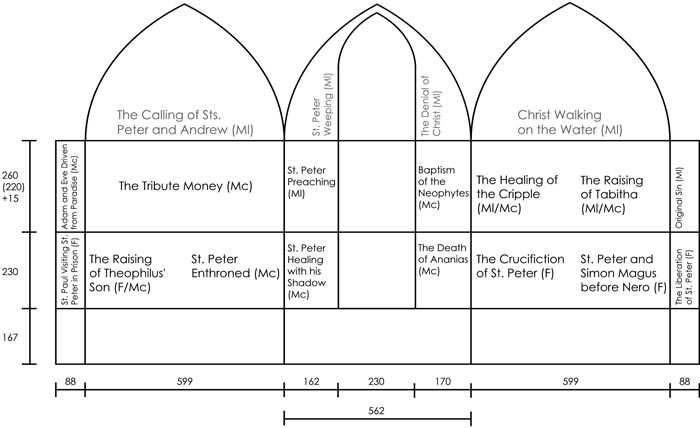 |
||
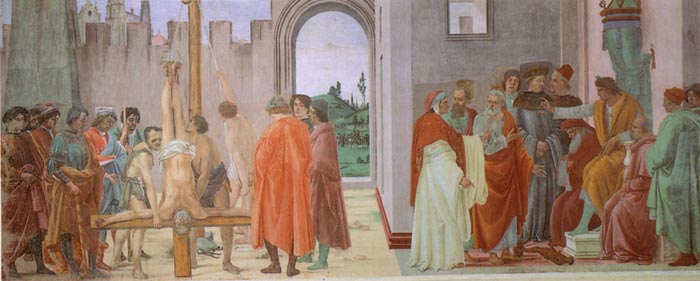 |
||
Filippino Lippi, Disputation with Simon Magus and Crucifixion of Peter, 1481-82, Brancacci Chapel, Church of Santa Maria del Carmine in Firenze
|
||
Art in Tuscany | Filippino Lippi | Brancacci Chapel in Santa Maria del Carmine, Florence |
||
Three Archangels with Young Tobias is a painting by the Italian Renaissance painter Filippino Lippi, dated 1485. It is housed in the Galleria Sabauda of Turin. On the background of a rocky landscape, resembling that of the London Adoration of the Magi, the picture represents the three archangels: Michael on the left, Raphael in the centre, and Gabriel holding a lily, together with a young Tobias, son of Tobit. The scene is clearly inspired to a Voyage of Tobias by Botticini, once in the Florentine church of Florence and now at the Uffizi, while the angels resemble those painted by Filippino himself in the Liberation of St. Peter in the Brancacci Chapel. The work was once attributed to Sandro Botticelli or his workshop. |
||
Strozzi Chapel |
||
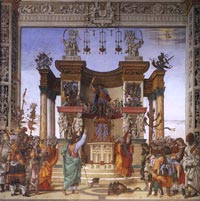 St Philip Driving the Dragon from the Temple of Hieropolis |
||
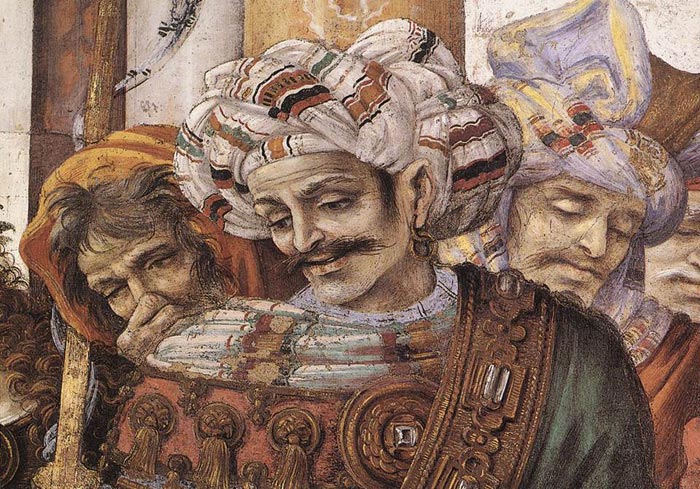 |
||
Filippino Lippi, St Philip Driving the Dragon from the Temple of Hieropolis (detail), Filippo Strozzi Chapel |
||
| The Vision of St Bernard | ||
| The high point of the early phase of Lippi's development is the Vision of St Bernard, one of the finest lyric pictures of the entire Renaissance. St Bernard of Clairvaux, seated at a desk with his pen poised, experiences a vision of the Virgin, who regularly had been the subject of his writings. The confrontation takes place out-of-doors (rather than in his study or in a church), enframed ingeniously by an outcropping of rock that creates a natural bench and bookshelves for the scholar. Behind Bernard, in the dark reaches of the rock, are two chained demons, while in the zone above, Cistercian monks converse or look heavenward in front of their fine Renaissance abbey. Still higher in the composition, a sick old man is being carried down toward the building. On the other side, a sweet landscape sweeps the eye into the distance. The format of the main figural group is echoed by the stony backdrop which, roughly speaking, forms a pyramid. Also included are the donor, Francesco del Pugliese, matched pictorially on the other side by the blond angel, leaning inward, hands clasped in prayer. The colours are confident, bright, and direct, adding to the exceptional visual excitement of the painting. Mary hovers above the ground facing Bernard. Her elegant form and finely silhouetted head are not dependent upon vigorous light-to-dark juxtapositions or even, as with Botticelli, a felicitously found, heavily accented line, but rather on the operation of fragile edges. The same is true for the figure of the saint, where light, colour, and lustrous paint, presumably oil, combine to produce the desired effect. The landscape is rather flat, despite all the implications of deep space. The painting, although not dated, may have been finished by 1485, the approximate completion date for another project of considerable importance, the Brancacci Chapel frescoes. |
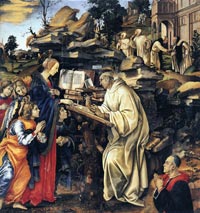 Filippino Lippi, Apparition of The Virgin to St Bernard, 1486, Church of Badia, Florence |
|
Major works |
||
* The Coronation of the Virgin (c. 1480) - Tempera on panel, 90,2 x 223 cm - National Gallery of Art, Washington * Madonna with Child, St Anthony of Padua and a Friar (before 1480) - Tempera on wood, 57 x 41,5 cm, Museum of Fine Arts, Budapest * Tobias and the Angel (c. 1480) - Tempera on panel, 33 x 23 cm, National Gallery of Art, Washington, DC * Portrait of an Old Man (1485) -Detached fresco, 47 x 38 cm, Uffizi, Florence * Three Angels with Young Tobias (1485) - Oil on panel, 100 x 127 cm, Galleria Sabauda, Turin * Self-Portrait - Detached fresco on flat tile, 50 x 31 cm, Uffizi, Florence * Portrait of a Youth (c. 1485) - Wood, 51 x 35,5 cm, National Gally of Art, Washington * Signoria Altarpiece (Pala degli Otto) (1486)) - Tempera on wood, 355 x 255 cm, Uffizi, Florence * Annunciation with St. Thomas and Cardinal Carafa (1488–1493) - Fresco, Santa Maria sopra Minerva, Rome * Apparition of the Virgin to St. Bernard (1486) - Oil on panel, 210 x 195 cm, Church of Badia, Florence * Madonna with Child and Saints (c. 1488) - Oil on wood, Santo Spirito, Florence * St. Jerome, (1490s) - Oil on wood, 136 x 71 cm, Uffizi, Florence * Madonna and Child with Sanits, dated1498, affresco, cm 239 x 141x 71, Prato, Museo Civico * Adoration of the Magi (1496) - Oil on wood, Uffizi, Florence * Allegory (c. 1498) - Oil on wood, 29 x 22 cm, Uffizi, Florence * Allegory of Music (Erato) (c. 1500) - Tempera on panel, 61 x 51 cm, Staatliche Museen, Berlin * Crucifixion, 1501 ca, tempera on panel, 31,2x 23,4 cm, Prato, Museo Civico * Mystic Marriage of St Catherine (c. 1501-1503 -Panel, Basilica di San Domenico, Bologna * Madonna and Child, St. Stefan and e St. Jhon the Baptist, 1502–1503, tempera on panel, 132x 118 cm, Prato, Museo Civico * Deposition (1504, finished by Perugino in 1507) - Oil on panel, 333 x 218 cm, Gallerie dell'Accademia, Florence |
||
[1] |
||||
Art in Tuscany | Art in Tuscany | Giorgio Vasari | Lives of the Most Excellent Painters, Sculptors, and Architects |
||||
|
This page uses material from the Wikipedia articles Filippino Lippi and Brancacci Chapel, published under the GNU Free Documentation License. |
||||
Residencyin Toscany for writers and artists | Podere Santa Pia
|
||||
Podere Santa Pia |
Podere Santa Pia |
View from terrace with a stunning view over the Maremma and Montecristo |
||
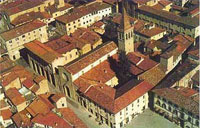 |
||||
Montefalco |
Piazza della Santissima Annunziata in Florence |
Sansepolcro |
||
| Pitigliano | Pienza |
Abbey of Sant'Antimo |
||
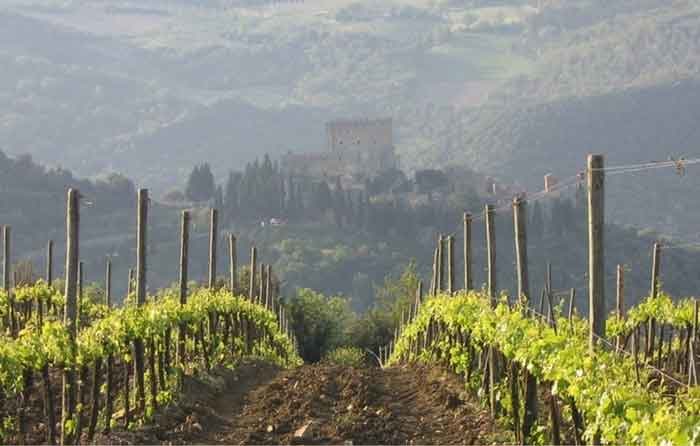 |
||||
Morning view on the Maremma and his vineyards |
||||
| Montalcino and Montepulciano are two engaging hill towns in southern Tuscany, embellished with historic architecture and Renaissance art. Scrolling around the narrow alleys of Montepulciano and Montalcino, while you can admire one of the best example of middle-ages and Renaissance architecture and urban life. Both Montalcino and Montepulciano are also well known for their wines, Brunello di Montalcino and Vino Nobile di Montepulciano. |
||||

